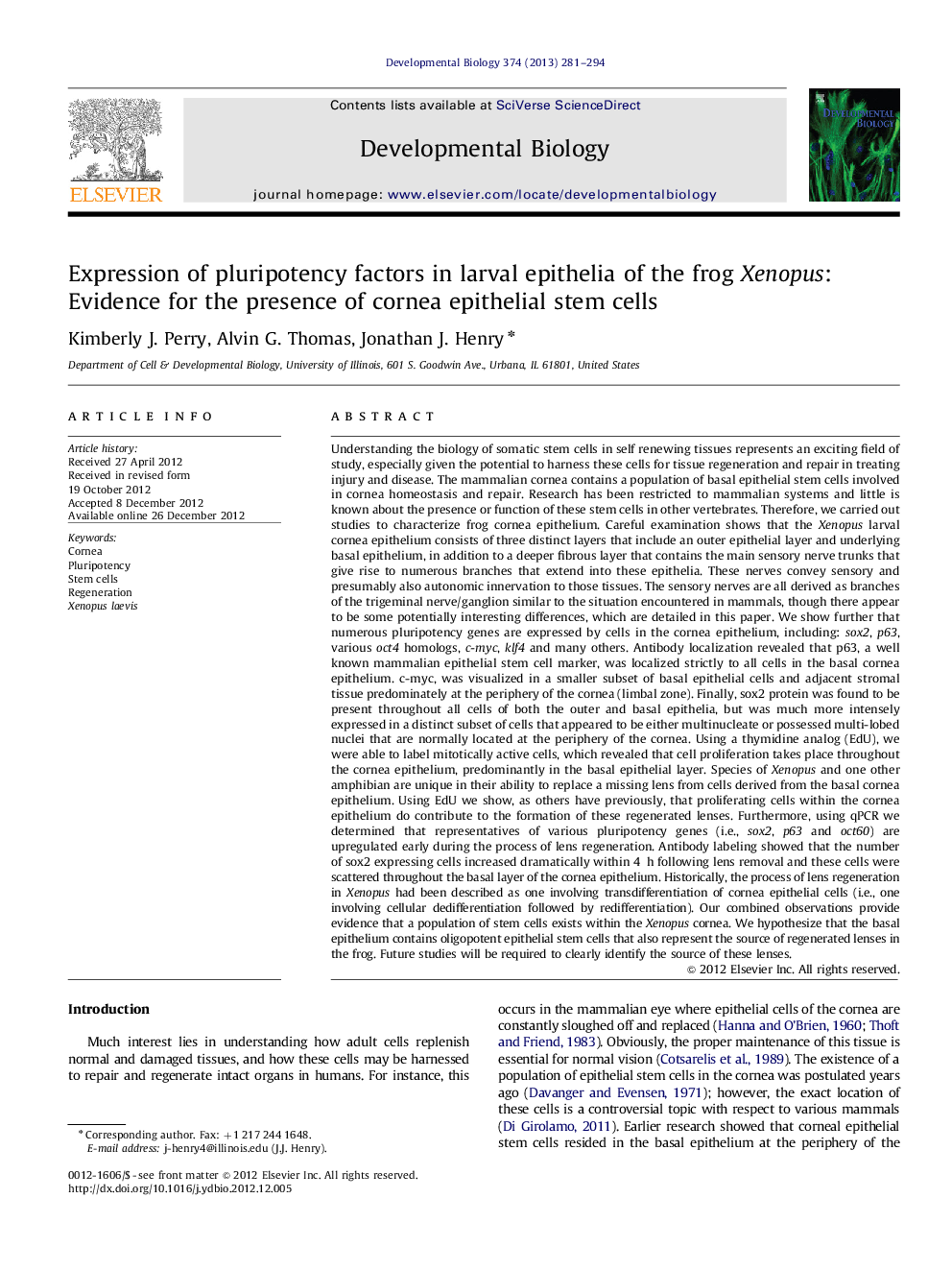| کد مقاله | کد نشریه | سال انتشار | مقاله انگلیسی | نسخه تمام متن |
|---|---|---|---|---|
| 2173171 | 1093700 | 2013 | 14 صفحه PDF | دانلود رایگان |

Understanding the biology of somatic stem cells in self renewing tissues represents an exciting field of study, especially given the potential to harness these cells for tissue regeneration and repair in treating injury and disease. The mammalian cornea contains a population of basal epithelial stem cells involved in cornea homeostasis and repair. Research has been restricted to mammalian systems and little is known about the presence or function of these stem cells in other vertebrates. Therefore, we carried out studies to characterize frog cornea epithelium. Careful examination shows that the Xenopus larval cornea epithelium consists of three distinct layers that include an outer epithelial layer and underlying basal epithelium, in addition to a deeper fibrous layer that contains the main sensory nerve trunks that give rise to numerous branches that extend into these epithelia. These nerves convey sensory and presumably also autonomic innervation to those tissues. The sensory nerves are all derived as branches of the trigeminal nerve/ganglion similar to the situation encountered in mammals, though there appear to be some potentially interesting differences, which are detailed in this paper. We show further that numerous pluripotency genes are expressed by cells in the cornea epithelium, including: sox2, p63, various oct4 homologs, c-myc, klf4 and many others. Antibody localization revealed that p63, a well known mammalian epithelial stem cell marker, was localized strictly to all cells in the basal cornea epithelium. c-myc, was visualized in a smaller subset of basal epithelial cells and adjacent stromal tissue predominately at the periphery of the cornea (limbal zone). Finally, sox2 protein was found to be present throughout all cells of both the outer and basal epithelia, but was much more intensely expressed in a distinct subset of cells that appeared to be either multinucleate or possessed multi-lobed nuclei that are normally located at the periphery of the cornea. Using a thymidine analog (EdU), we were able to label mitotically active cells, which revealed that cell proliferation takes place throughout the cornea epithelium, predominantly in the basal epithelial layer. Species of Xenopus and one other amphibian are unique in their ability to replace a missing lens from cells derived from the basal cornea epithelium. Using EdU we show, as others have previously, that proliferating cells within the cornea epithelium do contribute to the formation of these regenerated lenses. Furthermore, using qPCR we determined that representatives of various pluripotency genes (i.e., sox2, p63 and oct60) are upregulated early during the process of lens regeneration. Antibody labeling showed that the number of sox2 expressing cells increased dramatically within 4 h following lens removal and these cells were scattered throughout the basal layer of the cornea epithelium. Historically, the process of lens regeneration in Xenopus had been described as one involving transdifferentiation of cornea epithelial cells (i.e., one involving cellular dedifferentiation followed by redifferentiation). Our combined observations provide evidence that a population of stem cells exists within the Xenopus cornea. We hypothesize that the basal epithelium contains oligopotent epithelial stem cells that also represent the source of regenerated lenses in the frog. Future studies will be required to clearly identify the source of these lenses.
► Cells within Xenopus cornea epithelia express numerous pluripotency factors.
► Scattered cells in basal cornea epithelia express p63, sox2 and c-myc.
► Active cell proliferation takes place throughout the cornea epithelium.
► These results suggest that Xenopus corneas contain basal epithelial stem cells.
► Cornea epithelial stem cells could be the source of regenerated lenses in Xenopus.
Journal: Developmental Biology - Volume 374, Issue 2, 15 February 2013, Pages 281–294